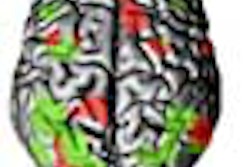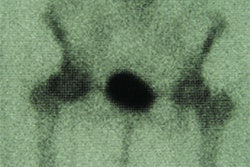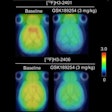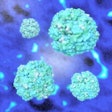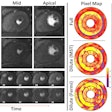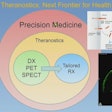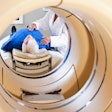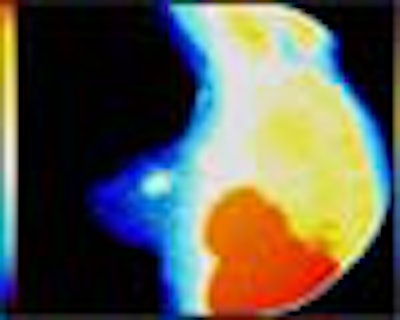
Evidence continues to mount in support of scintimammography (SMM) as a second-line test for detecting potential breast cancer. The latest study out of the United Kingdom shows that SMM, when combined with traditional mammography, can improve diagnostic accuracy.
Dr. John Buscombe and his co-authors from the departments of nuclear medicine and radiology at Royal Free Hospital in London performed a retrospective review of 353 consecutive female patients. Over a five-year period, all of them were imaged with both mammography and SMM for suspected primary breast cancer. The results are published in the latest issue of the Journal of Nuclear Medicine.
Standard two-view mammography was performed using a dedicated mammography unit (DMR, GE Medical Systems, Waukesha, WI). Criteria for diagnosing cancer included the appearance of spiculated or irregular dense lesions and changes in breast tissue architecture.
SMM was performed 5-10 minutes after an intravenous injection of 740 MBq 99mTc-MIBI (DuPont Pharmaceuticals, N. Billerica, MA).
"All patients were imaged using prone-dependent lateral and supine anterior planar imaging. This method was used to provide maximum separation of the breast from underlying thoracic activity. Planar images were obtained…with an acquisition time of 10 minutes for both lateral and anterior views, using a two-headed gamma camera (Prism 2000XP, Marconi Medical Systems, Cleveland)," the authors wrote (JNM, January 2001, Vol.42:1, pp.3-8).
The scintimammogram above demonstrates good focal uptake at the site of an invasive ducatl carcinoma. The clarity of the image contrasts with the difficulty in seeing such cancers within the dense breast. Image courtesy of Dr. John Buscombe.
Focal uptake of 99mTc-MIBI in at least one planar image of the breast was the criterion for evaluating an image as suggestive of malignancy, they added.
The mean time interval between the two exams was six days, to accommodate both clinical demands and patient scheduling, Buscombe explained to AuntMinnie.com. In some cases, the patient had undergone biopsy so there was a seven-day wait between the mammogram and the SMM exam.
The images were scored on a scale of one to five, with five representing definite cancer and one indicating benign results.
"A false-positive result was defined when the images were reported as probably or definitely cancer or equivocal but there was no malignant tumor," the paper stated.
Based on histologic samples obtained from mastectomy or excision biopsy, a diagnosis of malignancy was made in 204 out of 374 lesions. Mammography followed by SMM yielded a sensitivity of 93% for identifying cancer. Specificity was 72%, positive predictive value (PPV) was 80%, and negative predictive value (NPV) was 90%.
Individually, the modalities did not fare as well, the group reported. SMM correctly pinpointed 181 malignant lesions with 49 false positives. SMM had a sensitivity of 89%, a specificity of 71%, PPV of 79%, and an NPV of 84%.
In comparison, traditional mammography was able to identify 143 malignant lesions with 117 true-negative studies. The sensitivity for mammography was 70%, while specificity was 69%. The PPV was 73% and the NPV was 66%.
"We have found that in the diagnosis of primary breast cancer, the addition of SMM to x-ray mammography gives a significant increase in the accuracy of breast imaging," the authors wrote. "Although sonography is thought to be the main second-line imaging test in breast cancer, it rarely provides information independent of mammography because the sonography is directed by the mammography report."
The advantage of SMM is its ability to see cancer more clearly, based on the uptake of the radionuclide, rather than on a qualitative pattern of abnormalities. The authors concluded that radionuclide uptake is not affected by breast density or scarring.
Other recent studies have come to similar conclusions. In a study out of Murcia, Spain, researchers compared 99mTc-MIBI scintigraphy to mammography for diagnosing cancer in women with dense breasts, architectural distortion after surgery or radiation therapy, or younger patients under 30 years of age.
In those with dense breasts, scintimammography yielded a sensitivity of 88% versus 81% with mammography. In those patients with previous treatment, scintimammography’s sensitivity was 80% and its specificity was 100%. Finally, in younger women, scintimammography had a sensitivity and a specificity of 100%, while mammography had a sensitivity of 50% and a specificity of 20% (Revista Española de Medicina Nuclear, September 2000, Vol.19:5, pp.344-349).
Researchers from the Crump Institute for Biological Imaging at UCLA conducted a decision analysis to determine the cost-effectiveness of sestamibi scintimammography (SSMM) in order to minimize unnecessary biopsies.
The group compared conventional mammography alone (strategy A) to SSMM after an indeterminate mammogram (strategy B) or SSMM (strategy C) after both a positive and indeterminate mammogram. Based on Medicare reimbursement, strategy B was $9 less per patient than strategy A, while strategy C was $20 less per patient compared to traditional x-ray.
"This translates into respective savings of $189 [million] and $420 million per year assuming 21 million females undergo screening each year," they concluded (Quarterly Journal of Nuclear Medicine, June 2000, Vol.44:2, pp.168-185).
Buscombe said that his group had not conducted a financial analysis, but the extra cost associated with scintimammography in the U.K. would make it worthwhile.
"For us, the added gain in diagnostic yield makes scintimammography [costing two times as much as ultrasound] a good value, especially as the cost of missing a cancer, if sued, is about $1 [million] to $2 million (U.S.)," he said.
By Shalmali PalAuntMinnie.com staff writer
February 26, 2001
Related Reading
PEM gets FDA nod for breast imaging device, February 14, 2001
Positron emission mammography shows promise, January 5, 2001
Lorad to distribute Gamma Medica scintigraphy camera, December 6, 2000
FDG-PET gains favor among referring doctors for cancer staging, treatment, June 7, 2000
Click here to post your comments about this story. Please include the headline of the article in your message.
Copyright © 2001 AuntMinnie.com






